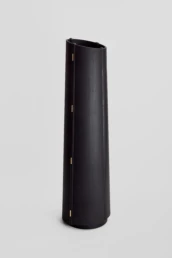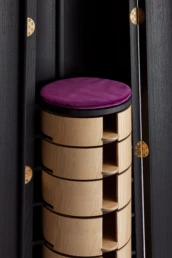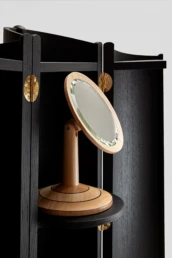Why the World Needs Craft (And More Handwriting)
A recent article in The Guardian posed a thought-provoking question: are we losing the ability to write by hand? In an age of voice-to-text and lightning-fast keyboards, it’s a fair concern. But the decline of handwriting isn’t just about a dwindling skill—it’s a symptom of something bigger. It’s about losing our connection to the tangible, the personal, the crafted.
As fewer people put pen to paper, we risk losing not just legible penmanship but also the deeper benefits of writing by hand: mindfulness, personal expression, and a connection to our thoughts.
In the workshop, we’re passionate about keeping hands-on practices alive. When we recently designed our wooden pen tray, we set out to make something more than a functional accessory. It’s a small celebration of craftsmanship—a tactile antidote to the fast pace of instant communication.
Handwriting: A Quiet Resistance
Handwriting in 2025 feels almost radical. It’s deliberate, slow, and imperfect—everything the digital world is not. But that’s precisely why it matters. Each letter you write reflects your individuality and state of mind; it’s a unique and irreproducible moment.
We wanted to reflect this ethos in our pen tray. Each one is crafted using steam-bent ash, and every curve is shaped by the unique grain of the wood. Just as no two handwritten letters are identical, no two trays are exactly the same.
Making Is Thinking: The Craft Connection
As Richard Sennett notes in The Craftsman, “making is thinking.” The same principle applies to writing. When you write by hand, your thoughts slow down, becoming more deliberate and reflective.
This philosophy is also at the heart of how we make our trays. Every bend of the wood is intentional, every curve carefully considered. The process mirrors the experience of handwriting: steady, thoughtful, and intentional. In both craft and writing, we find rare opportunities to slow down and engage with the moment.
Objects That Mean Something
Why does any of this matter? Because the tools we surround ourselves with shape how we live. A pen tray may seem like a small thing, but when it’s crafted with care, it becomes a quiet partner—whether you’re taking notes on a Teams call, writing a love letter, brainstorming ideas, or simply enjoying the feel of pen on paper.
Mass production gives us countless disposable options, but we believe in making things that last, that feel good in the hand, that have a bit of a story.
The Handwritten & the Handmade
As handwriting and the handcrafted become less common, they feel more precious. They carry forward traditions and skills that connect us to history and to ourselves. In a fast-paced world, it’s worth pausing to appreciate the tools that enable these moments of reflection.
Of course, at the end of the day it’s just a wooden tray for storing pens, but we like to think of it as a small yet meaningful symbol of what we stand to lose if we let the tactile, human elements of our lives slip away. By surrounding ourselves with well-crafted objects and taking time to write by hand, we keep a little of that, and that can only be a good thing.
Recreating the Gates of Homeyards Botanical Gardens in Shaldon, Devon
In spring 2024, we had the pleasure of taking on a special commission for the friends of Homeyards Botanical Gardens in Shaldon, Devon. We were asked to recreate a set of gates that had stood for decades. The original gates, weathered by years of coastal air, were beyond repair, and our brief was clear: to replicate them exactly, using traditional joinery techniques throughout. Situated in a beautiful coastal setting, the 1920s gardens deserved nothing less than the same craftsmanship that had first shaped them.
Homeyards Botanical Gardens is a hidden gem located on the hillside above the village of Shaldon. The gardens were designed in the 1920s by Italian garden designer Giacomo Bosio and commissioned by Maria ‘Laetitia’ Kempe Homeyard. Originally created to complement the nearby castle she had built, the gardens are known for their mix of formal and informal landscaping, which includes rockeries, a castle-style folly, a lily pond, and terraced walks with sweeping views over the Teign Estuary and the sea.
Having all trained in heritage joinery, it was a pleasure to work with pegged mortice and tenon joints, just as the original makers had. We used English air-dried oak throughout, staying true to the materials and methods of the past. It was a project that called for precision and care, and we were proud of the final result.

The gates installed at the Homeyards Botanical Gardens, Shaldon, Devon
What made the project even more meaningful was a chance encounter during the installation. We met the craftsman who had built the gates we were replacing. He’d made them in the late 1960s as a joiner’s apprentice, tasked with copying the original 1920s gates. Hearing his story was a reminder that we were part of a long and ongoing tradition, a continuity of craftsmanship passed down over a hundred years.
In the end, the gates will continue to perform their function for the assorted dog walkers of Shaldon, but behind them is a lineage of craftsmanship that has quietly continued through the decades. It’s lovely to have played a small part in that story, preserving the character of this special place for years to come.
Lines Cabinet Wins Best in Show and Bespoke Prize in Young Furniture Makers Awards
We are delighted to announce that our Lines Cabinet, designed and made by Josey Garbutt has won both The Bespoke Award, sponsored by Axminster Tools and Best in Show Prize, prize sponsored by Blum.
“Looking at the standard of work, I was hugely honoured to win first prize for the Bespoke Award. To then discover that my Lines Puzzle Cabinet had won Best in Show was incredible and I am absolutely delighted. It was also very satisfying to see the experts and other visitors having fun, playing with my cabinet and watching their reactions to the surprise elements.”
– Josey Garbutt
The Furniture Makers Company is an incredible organisation and it means alot to have our work recognised by them.

Lines cabinet, designed and made by Josey Garbutt
More information including the other winners can be found here. You can also find out more about the Furniture Makers Company and the amazing work they do supporting furniture making in the UK.
Rediscovering Ancient Woodland Management: Sustainable Design Insights from the Past
The ancient woodlands of the UK, shaped by centuries of management, offer a remarkable template for contemporary sustainable design practices. Traditional methods such as coppicing provide insight into how people once worked harmoniously with nature. These time-tested practices, when examined alongside modern design thinking, inspire a return to sustainability rooted in both material stewardship and emotional durability. This article delves into the history of woodland management and explores how these ancient principles can inform ethical and sustainable design for the future.
A Brief History of Early Woodland Management in the UK
Following the last Ice Age, the once barren British landscape transformed into the lush woodlands we recognize today, populated by species such as oak, elm, birch, hazel, and lime (Taylor, 1982). However, human intervention, particularly from the early Neolithic period (4000–2400 BC), led to widespread deforestation to accommodate the growing need for agricultural land. According to environmental historian Oliver Rackham, roughly half of England had ceased to be wildwood by 500 BC due to early deforestation efforts.
“From Neolithic times onwards, parts of the wildwood, instead of being grubbed out, were evidently turned into managed woodland.” – Oliver Rackham (2001, p. 38)
Despite this large-scale deforestation, early communities developed a sustainable system of woodland management known as coppicing. Instead of simply clearing forests, they discovered that trees, when cut down to the stump, would regrow shoots that were far more useful than the original trunks. This practice not only allowed for the regeneration of forests but also provided communities with a continuous source of timber, firewood, and materials for construction.
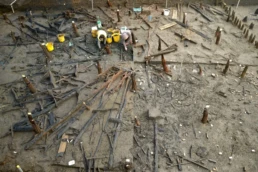
Excavations at Flag Fen show ancient use of coppiced woods
The Ancient Art of Coppicing
Coppicing is an age-old forestry technique that involves cutting trees down to their stumps and allowing them to regrow over a set period. This cyclical process enables forests to regenerate while providing communities with a sustainable, renewable supply of wood. The practice allowed early Neolithic people to use wood more efficiently, avoiding the impracticalities of transporting and processing large, mature logs.
Evidence of early coppicing can be seen at sites like Flag Fen, near Peterborough, where thousands of sharpened wooden poles were discovered as part of a large, prehistoric wooden causeway. These poles were selectively cut from regrown trees, showcasing the early mastery of coppicing techniques (Pryor, 2015).
Coppicing continued to evolve over the centuries and became an integral part of the economy. In the 16th century, the coppice and standards method was introduced, allowing for both timber production and the regular harvesting of smaller coppiced shoots. This system ensured forests remained productive for generations, striking a balance between sustainability and economic necessity.
Coppicing and Traditional British Crafts
Coppicing was not just a practice of forestry but also an essential part of British craftsmanship. Hurdle-making, for example, involved weaving coppiced hazel wood into strong, flexible fences that were widely used across the British countryside. In the 1960s, craftspeople like those in Verwood, Dorset (Reeks, 1968), were still practising this traditional skill, passing it down through generations.
These age-old crafts played a crucial role in rural life. In addition to hurdles, coppiced wood was used to make everything from baskets to furniture, road fences to fuel for heating and cooking. The system was designed to sustain local communities, creating objects that were both useful and long-lasting.

Hurdle making in Radnorshire. Image courtesy of the Watkins Collection
The Decline of Woodland Management and Its Consequences
The First and Second World Wars had a devastating effect on British woodlands. The enormous demand for timber during wartime nearly stripped the country of its ancient woodlands. By 1945, much of Britain’s woodlands had been depleted (Bartlett, 2011). The post-war effort to rebuild saw the government favour rapid replanting programs, introducing fast-growing species like Sitka spruce and Douglas fir to meet the urgent demand for timber. However, these monocultures lacked biodiversity, diminishing the ecological value of Britain’s woodlands.
“The Woodland Trust estimates that nearly 50% of ancient woodlands that survived into the 1930s was lost during this period.” – Woodland Trust and Tickell (2000)
Today, Britain remains one of the least wooded countries in Europe, with the National Statistics Office reporting that the UK is the second-largest net importer of forest products, behind only China.
Designing for Sustainability: The Role of Emotional Durability
In the context of today’s environmental crisis, it’s clear that merely focusing on sustainable materials is not enough. Design must also address consumption patterns and foster deeper emotional connections between people and the objects they use. The concept of emotional durability, introduced by Jonathan Chapman in his influential work Emotionally Durable Design, argues for creating products that are designed to last, not only physically but emotionally as well.
“The most common response to being asked how users formed emotional attachments to products was through narrative—a personal history with the product, often related to when, how, and from whom the object was acquired.” – Jonathan Chapman (2009, p. 33)
Objects crafted from responsibly sourced wood, particularly from sustainable practices like coppicing, carry with them a narrative rooted in history and environmental stewardship. These materials tell the story of a time-honoured relationship between humans and nature, one based on mutual benefit and respect.
A Plurality of Sustainable Solutions
“We are not looking for mass answers, but instead a mass of answers.” – Kate Fletcher (Chapman & Gant, 2007)
As Kate Fletcher writes, sustainable design cannot be a one-size-fits-all solution. Rather, it requires a variety of approaches that consider different materials, environments, and cultures.
In today’s design world, incorporating the lessons from ancient woodland management techniques like coppicing offers more than just eco-friendly benefits—it reconnects us with the past and fosters a deeper respect for the materials we use. Designing with these principles in mind helps us address both the environmental and ethical dimensions of sustainability, providing a framework for a more responsible, long-term approach to design and consumption.
Conclusion: Learning from the Past for a Sustainable Future
The history of woodland management in the UK, particularly the practice of coppicing, provides valuable insights into how we can design sustainably in the modern world. By combining ancient techniques with the concept of emotional durability, designers can create products that not only minimise environmental impact but also foster long-term emotional connections with users. This approach challenges the cycle of throwaway culture, encouraging a more thoughtful relationship with the objects we own.
At Foris Studio, we believe in the power of design to make a positive impact. By embracing sustainable materials, respecting traditional craftsmanship, and fostering emotional durability in our products, we strive to create timeless, meaningful designs that are as good for the planet as they are for the people who use them.
Design & Dislocation
“Because I know that time is always time
And place is always and only place
And what is actual is actual only for one time
And only for one place”
— T. S. Eliot, Ash Wednesday
When we attempt to trace the origins of ideas, particularly in design, there’s a temptation to simplify history into neat, localized narratives. We often conclude that design styles emerged because of a specific set of influences at a certain time in a certain place. However, reality is far more complex, as history is often nonlinear, interwoven with distant events and influences.
In design, the truth is even more fluid. Rather than viewing the emergence of design styles as a local phenomenon, we should consider how distance — both geographical and temporal — plays a critical role. Design has always been global, shaped by the movement of people, materials, and ideas across borders.
This post looks at three key moments in design history to illustrate how dislocation has shaped design, emphasizing the interplay between distance and influence. As we enter a new era where localism and sustainability are prioritized, it’s worth reflecting on how the global movement of materials and ideas has long influenced the evolution of design.
1. The Thames
Woodlands & the Windsor Chair
The Thames River serves as both a connector and a boundary between London and the countryside, and the story of the Windsor Chair illustrates how a design style can emerge through a complex interplay of places, people, and materials.
Historically, furniture design often carried a distinction between town and country styles, with town furniture typically more represented in museums and historical collections. However, the Restoration of Charles II in 1660 marked a shift in English design, spurred by a reaction against Puritan restraint and the influence of foreign craftsmen who brought Continental styles to the English court.
The exact origins of the Windsor Chair are uncertain, but its roots likely stretch back to Welsh “stick chairs,” first documented as early as the 13th century in the *Laws of Hywel Dda* manuscript. The chair that we recognize as the Windsor emerged from the beech wood forests of the Chilterns in Buckinghamshire. The spindles for the chairs were turned by local craftsmen, known as “bodgers,” who worked in the woods on rudimentary lathes, producing pieces that were eventually carried along the Thames and into London’s fashionable society.
Historian Nancy Goyne Evans offers a more nuanced view, arguing that London had already established itself as a center for turnery by the time the Windsor Chair appeared in records around 1724. According to her research, London was importing large quantities of beech from the Chilterns and may have already developed the techniques necessary for Windsor Chair production. By this theory, the chair was not purely a rural creation adopted by the elite, but rather a hybrid of influences, skills, and market demands.
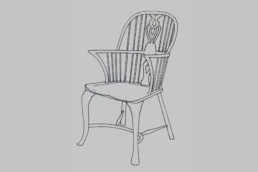
Chippendale Windsor with Cabriole Legs
Later, in the 18th century, Chippendale versions of the Windsor Chair emerged, illustrating the merging of country craftsmanship with fashionable urban tastes. These chairs, produced by rural artisans imitating Chippendale’s famous designs, demonstrate the ongoing interplay between town and country, with materials and influences flowing freely between the two worlds.
2. The Atlantic
Mahogany Trading
The story of mahogany furniture in 18th-century Britain reveals a much darker side of design history, tied to environmental destruction and human exploitation. Mahogany, now synonymous with wealth and refinement, carries within its grain a history of colonialism and slavery.
Initially, mahogany was little more than a byproduct of the sugar plantations in the West Indies, felled to clear land for cash crops. The logs were used as ballast on ships returning to Britain, often dumped on the quaysides of major ports. However, as cabinetmakers began to appreciate the qualities of this dense, durable wood, mahogany quickly became the preferred material for fine furniture.
By the mid-18th century, leading furniture makers such as Thomas Chippendale were using mahogany extensively. The wood’s hard texture and fine grain made it ideal for carving intricate designs, which filled the drawing rooms of Britain’s wealthy elite. However, the true cost of this “luxury” material was paid by the enslaved laborers in the Caribbean, forced to fell trees in brutal conditions. Mahogany was a product of environmental devastation and human suffering, as entire forests were cleared and enslaved workers labored in life-threatening conditions, as observed by Charles Dickens and Wilkie Collins, who noted the “retrospective mirror-quality” of a mahogany desk, reflecting the horrors endured by those who harvested the wood.
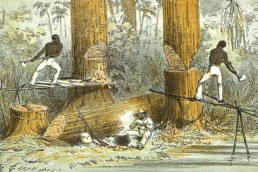
Felling mahogany in Honduras
Thus, while mahogany furniture represented wealth and sophistication, its origins tell a much darker story, linking British homes to the human and environmental exploitation that fueled the transatlantic economy. The “age of mahogany,” as furniture historian Percy Macquoid called it, is inextricably bound to the wider forces of colonialism and slavery.
3. The Baltic Sea
Workshops, Plywood, and Wartime Europe
The story of Gerald Summers and his Simple Furniture Company in 1930s London illustrates how the flow of materials, influenced by political and economic forces, can shape — and sometimes curtail — design movements.
Summers, who began his career as an engineer, founded the Simple Furniture Company with his wife Marjorie in 1929. He quickly gained recognition for his innovative use of plywood, a material that was relatively rare in Britain at the time. Inspired by modernist movements such as the Bauhaus and the designs of Finnish architect Alvar Aalto, Summers’ furniture was characterized by its clean lines and functional simplicity.
Plywood offered unique advantages: it was lightweight, strong, and could be molded into complex shapes. Summers’ use of aircraft plywood allowed him to push the boundaries of design, as seen in his iconic Fireside Chair, which was made from a single sheet of plywood. However, his refusal to scale production or stockpile materials proved to be his undoing.
When World War II broke out, Britain’s access to Baltic plywood was severely restricted, as the material was redirected for military use. Summers’ reliance on this imported resource meant that his company could no longer fulfill orders, and by 1940, the Simple Furniture Company had declared bankruptcy.
In contrast, Alvar Aalto’s company, Artek, based in Finland and closer to the birch forests, continued to thrive. Aalto’s designs, such as the Model 60 Stacking Stool, became iconic examples of modernist furniture. The geographic proximity to resources, combined with a willingness to scale production, allowed Aalto’s work to flourish where Summers’ could not. The dislocation caused by global conflict disrupted one designer’s vision while enabling another’s success.
Design & Dislocation
These three stories — the Windsor Chair, the mahogany trade, and the rise and fall of Gerald Summers’ plywood furniture — demonstrate that design is not an isolated, local phenomenon. It is shaped by the movement of materials, the migration of people, and the impact of distant events.
The Thames carried beech wood from the Chilterns to London; mahogany crossed the Atlantic at the cost of human suffering; plywood traveled from the Baltic to Britain, only to be redirected by war. These examples remind us that design emerges from a complex web of influences and interactions, rather than a single point of origin.
As we face new challenges in design, particularly the need for sustainability and localism, it’s crucial to remember the lessons of the past. Materials, ideas, and influences have always moved across borders, and while localism has its virtues, true innovation often comes from the interplay of the local and the global. Understanding the dislocated nature of design can help us create new models that are both environmentally conscious and open to fresh ideas.
Pen Box Wins the Ray Leigh Design Award from the Gordon Russell Museum
We’re excited to announce that our Pen Box has been awarded the Ray Leigh Design Award by the Gordon Russell Design Museum. This recognition celebrates our commitment to high-quality craftsmanship and innovative design, and we’re honoured to have our product recognised by such a distinguished institution.
What Is the Ray Leigh Design Award?
The Ray Leigh Design Award is given annually to designs that excel in creativity, functionality, and craftsmanship. It is presented by the Gordon Russell Design Museum, which is dedicated to promoting excellence in design. The award honours designers who, like us, are passionate about creating thoughtful and well-made products that combine utility with style.
Our Award-Winning Pen Box
The Pen Box is a carefully designed, minimalist accessory crafted to bring elegance and organisation to any workspace. Combining clean lines and carefully selected materials, it reflects our philosophy of merging simplicity with functionality. Whether used at home or in the office, this Pen Box adds a refined touch to daily life.
You can explore and purchase the award-winning Pen Box through our online store.
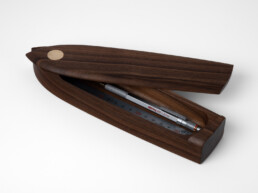
Pen Box in American black walnut & brass
About the Gordon Russell Design Museum
The Gordon Russell Design Museum is located in Broadway, Worcestershire, and is dedicated to celebrating the legacy of Sir Gordon Russell, a pioneering British furniture designer. The museum explores the evolution of design, from the Arts and Crafts movement to contemporary craftsmanship, showcasing pieces that highlight innovation and attention to detail.
Through awards like the Ray Leigh Design Award, the museum recognises and supports modern designers who continue to push the boundaries of design and craftsmanship, just as Sir Gordon Russell did.
Why This Award Matters
The Ray Leigh Design Award is a significant achievement for us. It acknowledges our commitment to creating products that blend aesthetic beauty with everyday functionality. Winning this award motivates us to continue developing designs that are not only visually appealing but also practical and durable.
You can find our Pen Box available in our online store or through Foris Studio.
Cochise Chair wins the Sanderson Design Group Textile Award
We’re pleased to share that the Cochise chair, designed by Krav Metcalfe at Foris Studio, was recently recognized at the Young Furniture Makers Exhibition, hosted by the Furniture Makers’ Company. Sponsored by the Sanderson Design Group, this exhibition highlights promising work by emerging designers, and we’re proud that the Cochise chair was selected.
Designing the Cochise Chair
The Cochise chair is an example of simplicity and craftsmanship, blending modern design principles with traditional techniques. A key feature of the chair is its use of Danish cord, a material chosen for both its durability and its connection to time-honored furniture-making practices.
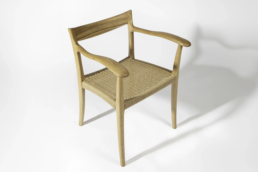
Cochise chair in English oak and Danish cord
What is Danish Cord?
Danish cord is a strong, tightly-wound paper fiber that has been used in furniture design—particularly chair making—since the mid-20th century, most famously in Scandinavian designs. It is typically woven by hand, forming a sturdy yet flexible surface for seating. Its natural appearance gives it a tactile, organic quality that complements wooden frames and minimalist aesthetics.
Danish cord weaving requires skill and precision. The method involves hand-weaving the cord in a specific pattern to ensure that the seat maintains both its shape and comfort over time. The craftsmanship involved in this process is one of the reasons Danish cord remains a popular material in high-quality furniture, bringing both beauty and function.
In the Cochise chair, Danish cord plays an essential role, both structurally and aesthetically. The seat is handwoven, creating a sturdy yet comfortable surface that contrasts with the clean lines of the chair’s frame. By incorporating this traditional weaving method, the design achieves a balance between modern minimalism and artisanal craftsmanship. The texture of the cord adds warmth and tactility, enhancing the experience of the chair as a whole.
A Thoughtful Approach to Design
The recognition of the Cochise chair at the Young Furniture Makers Exhibition, sponsored by the Sanderson Design Group, is a testament to our commitment at Foris Studio to combining thoughtful design with skilled craftsmanship. Krav Metcalfe’s approach highlights how materials like Danish cord, when used with care and attention, can elevate a design beyond aesthetics, making it both functional and enduring.
Obelisk 3 by John Makepeace OBE
We are delighted to announce a commission by John Makepeace OBE to make Obelisk 3, a significant new piece. Continuing his practice of creating innovative furniture of uncompromising quality, John Makepeace approached us after seeing their work at the Young Furniture Makers Awards, organised by the Furniture Makers Company in London in 2023. The resulting piece, Obelisk 3, uses innovative new techniques to produce a striking cabinet, with a blackened oak exterior and a contrasting rippled sycamore interior. Executed with an exacting level of craftsmanship the piece was recently exhibited by Sarah Myerscough Gallery at TEFAF art fair in Maastricht.
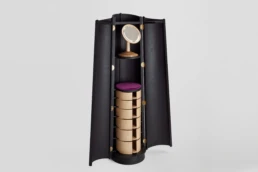
John Makepeace OBE
John Makepeace OBE is internationally regarded as one of Britain’s most influential designer-makers. He was an early proponent of material innovation and sustainability, setting up the acclaimed Parnham College for furniture designers in 1977 and initiating the development of the new campus at Hooke Park to encourage closer liaison between foresters, designers and manufacturers.
John Makepeace was a founding member of the Crafts Council UK in 1975. From 1987–91 he was a trustee of the Victoria & Albert Museum, London. He was awarded an OBE in 1988 for his services to furniture design and in 2004, he received a Lifetime Achievement Award from the American Furniture Society.







